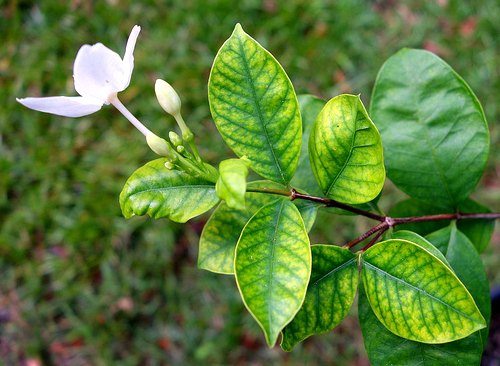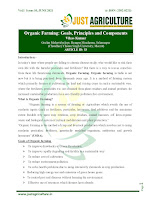General Symptoms of Plant Disease: Plant Pathology Notes
1. Necrosis:- Death of cells, tissues and organs caused by pathogen. e.g. - Spots, blights, canker, streaks, damping-off etc.
2. Wilt:- Drying and drooping of plant organs due to loss of turgidity. Wilting takes place due to blockage in the translocation system caused by the pathogen.
3. Die-back:- Drying of plant organs like twigs or branches from the top to downward.
(a). Downy Mildew:- Downy feather like growth on the lower surface of the leaf, is called Downy Mildew.
8. White blisters:- Several white, blister like pustules emerges out by breaking the host surface and expose white powdery mass of spores. It is common in Cruciferous plants.
9. Colour change:- It indicates conversion of green pigment of leaves into other colours mostly to yellow colour, in patches or covering the entire leaves.
(ii) Chlorosis:- Yellowing of plant organs due to infection caused by viruses, bacteria, fungi, low temperature or deficiency of nutrients etc.
10. Exudation:- Mass of bacterial cells ooze out at surface of the affected plant organ and from some drops or smear, is called Exudation.
11. Overgrowth:- Excessive growth of the plant parts due to infection by pathogens.
Overgrowth is two types:-
(b). Hypertrophy:- Abnormal increase in size or shape of plant organ due to excessive enlargement of the size of cells.
12. Atrophy:- It is phenomenon in which plant growth is inhibited due to decrease rate of cell division or reduction in cell size.
13. Sclerotia:- These are dark and hard structures of various shaped composed of dormant mycelia of some fungi.
14. Scab:- A roughened or crust-like lesion appearance at infected plant organ. It is most common in Apple and Potato etc.
17. Damping Off:- Destruction or rotting of seedling near the soil surface, which cause falling of seedling on the ground.
20. Mosaic:- Alternate pattern or intermingled patches of light green and yellow color.
Crop Diseases and Their Pathogen Names: Agricultural Plant Pathology
🔹DISEASES OF RICE
(2). Rice brown leaf spot - Helminthosporium oryzae
(3). Narrow brown leaf
spot of rice- Cercospora oryzae
(6). Stem rot of rice - Sclerotium oryzae
(7). Sheath rot of rice - Sarocladium oryzae
(8). Bacterial leaf blight - Xanthomonas oryzae pv. oryzae
(9). Bacterial leaf streak - Xanthomonas campestris p.v. oryzicola
(10). Tungro disease - Rice Tungro Bacilliform Virus (RTBV)
Rice Tungro Spherical Virus (RTSV)
Vector - Green Leaf Hopper (Nephotetix virescence)
🔹DISEASES OF WHEAT AND BARLEY
(5). Karnal bunt - Neovossia indica
(6). Leaf blight - Alternaria triticina
(7). Tundu disease or yellow slime
disease - Anguina tritici (Nematode) +Corynebacterium tritici or
Clavibacter tritici
(8). Powdery Mildew - Erysiphe graminis tritici
(10). Hill Bunt - Tilletia foetida
(11). Covered Smut of Barley - Ustilago hordei
(13). Powdery Mildew of Barley - Erysiphe graminis var. hordei
🔹DISEASES OF SORGHUM
(3). Rust -Puccinia purpurea
(4). Leaf blight or leaf stripe -Trichometasphaeria turcica
(6). Downy Mildew or Leaf shredding - Peronosclerospora sorghi
(7). Leaf Rust - Puccinia purpurea
(8). Long Smut - Tolyposporium ehrenbergii
🔹DISEASES OF PEARLMILLET
(2). Ergot of Bajra - Claviceps fusiformis
(3). Smut of Bajra - Tolyposporium penicillariae
🔹DISEASES OF MAIZE
(1). Turcicum Leaf blight -Helminthosporium turcicum.
(2) Cephalosporium wilt -
Cephalosporium maydis
(4). Banded leaf and sheath
blight- Rhizoctonia solani.
(5). Seedling Blight - Pythium aphanidermatum
(6). Smut of Maize - Ustilago maydis
🔹DISEASES OF SUGARCANE
(4). Ratoon Stunting Disease of Sugarcane - Clavibacter xyli sub sp. xyli
(5). Red Stripe - Xanthomonas rubrilineans
(6). Pineapple Disease/ Sett Rot - Ceratosystis paradoxa
🔹DISEASES OF POTATO
(3). Scab - Streptomyces scabies
🔹OTHER CROP DISEASES
(2). Ascochyta Blight of Gram - Ascochyta rabiei
(4). Sterility Mosaic - Viral disease
Vector - Eriophyid Mite (Aceria vajani)
(6). Collar rot disease of Groundnut - Aspergillus niger
(8). Alternaria Blight of Crucifers - Alternaria brassicae
DISEASES OF FRUIT CROPS
(2). Bunchy Top - Viral disease
(6). Greening Disease of Citrus
(7). Tristeza of Citrus - Viral disease
Vector - Toxoptera citricida
Note:- All the pictures included in the blog have been taken from the various internet sources. All the right of the pictures are secured to their owners. Pictures are only used here for the fair use of content for educatioal purpose.
Thank You
Vikas Kashyap:)











































































1 Comments
Nice content....keep it up bro
ReplyDelete